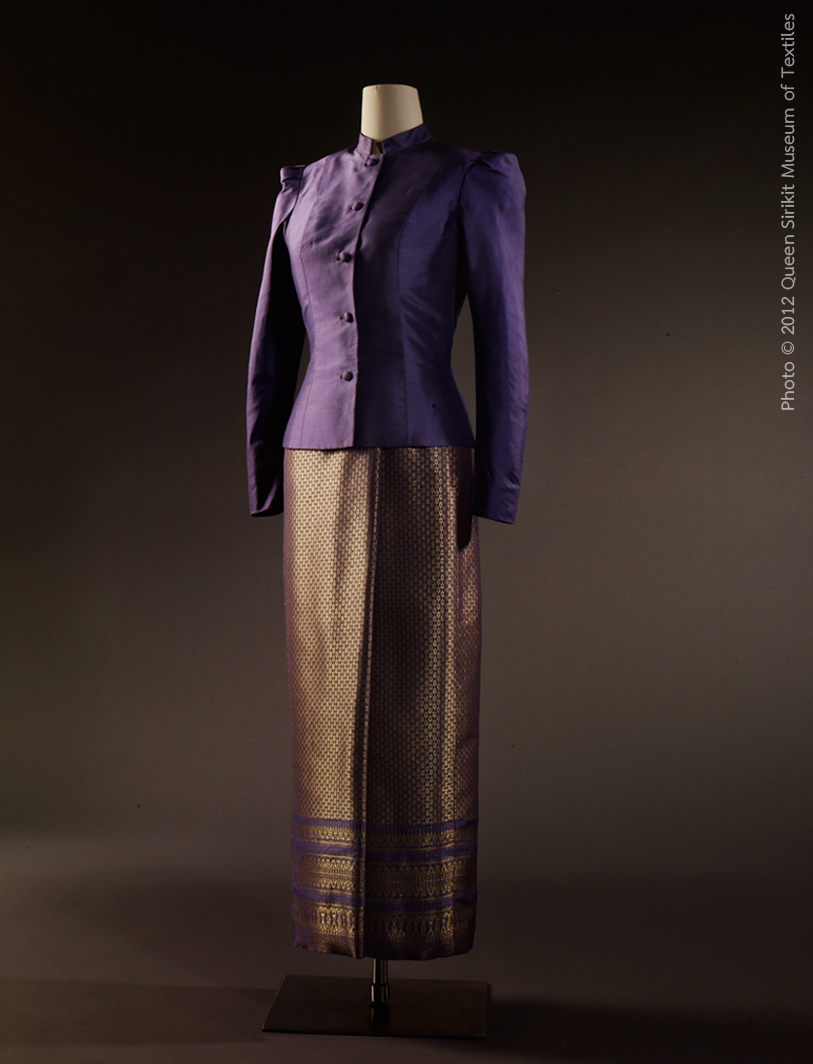The country of Thailand, which is divided into several geographical regions, is home to more than 30 ethnic groups, though the Thai majority make up ca. 75% of the population (the central Thai or Siamese, the eastern Thai or Lao, the northern Thai or Lao and the southern Thai or Chao Pak Thai). The north of the country is mountainous and is home to the twenty different Hill tribes (see Thailand: hill tribes). There are also communities of people from China, Tibet, Vietnam, Burma and Laos.
Traditional clothing
There is no official Thai national dress, however, the various indigenous ethnic groups of Thailand have traditionally produced a wide variety of handwoven textiles, with each group being identified by their distinctive combinations of fibre, colour and techniques.
A length of cloth traditionally made of cotton or silk called the pha khao ma or pakama is valued for its versatility throughout Thailand: it is a sort of multipurpose loincloth. It is worn not only as a skirt or sash but also as a head cloth or hat. The pakama is additionally used as a blanket, towel, makeshift fan, hammock for children, floor covering or tablecloth. Despite being found across Thailand, pakama are closely associated with the regional identity of Isaan (NE Thailand).
A traditional form of garment worn by both Thai men and women is the chong kraben. This is a length of cloth that is wrapped around the body and tied in a knot at the waist. The ends of the cloth are brought together and rolled from the top edge to the bottom edge and the resulting roll brought through the legs and tucked at the small of the back into a belt. Neither women nor men originally worn upper garments, but since the 1930s/1940s women have been forbidden from going topless.
In addition, there are unofficial national costumes based on the traditional dress of the Thai elite (see below).
Women’s wear
Women wear a tube-like skirt called phasin or pha sin made of a piece of cloth 3 yards long and more than 1 yard wide (ca. 3 x 1 m). It was introduced by King Rama VI (1880–1925). The phasin has three sections: top (hua sin), midsection or body (tua sin), and the foot or border (tin sin). These sections are often made of different materials or designs. The more formal the occasion the more luxurious the materials used. For formal occasions a sash is worn running from the left shoulder to the right side of the waist.
In the 1960s, this style of costume was modernised by Queen Sirikit, wife of King Rama IX (1927— 2016) and turned into eight different costumes.
Day-to-day costumes
1) Thai Chitlade: daytime formal wear. The phasin has a brocaded band along the hem, while the top is a long-sleeved silk blouse, opened at the front with five silver or gold buttons.
2) Thai Ruean Ton: This is basically a phasin with a collarless blouse with elbow-length sleeves and a front opening.
Formal costumes
1) Thai Amarin: evening wear. The blouse is wide and has a round neck, with sleeves just below the elbow. The phasin is made of brocade.
2) Thai Boromphiman: evening wear. The top looks like a long-sleeved blouse with a rounded or mandarin-style collar. It is buttoned either at the back or front. The ankle-length brocade phasin has front pleats.
3) Thai Chakkraphat: this is a silk dress with a pleated embroidered shawl over a second shawl which covers the top part of the dress.
4) Thai Chakkri: This costume is usually made using a special weaving technique called yok, which often has gold- or silver-coloured threads woven into the fabric. The phasin has two pleated folds at the front and is called a na nang.
5) Thai Dusit: wide-necked, sleeve-less brocaded costume/dress made of yok silk used as evening attire. The top and bottom can be sewn together.
6) Thai Siwala: formal costume similar to Thai Boromphiman but with a shawl over the shoulders (see Fig. 4).
Men’s wear
The national costume for men is called suea phra rachathan. It consists of a white (or another colour) jacket (phraratchathan) with a mandarin collar slightly tapering at the side, which was invented for the Thai king in 1979 and resembles the so-called ‘Nehru jacket’ and trousers. The jacket may have side vents or not. It has five cloth buttons and two outer pockets at the front. It may also have a breast pocket on the left. The phraratchathan has two varieties: short-sleeved and long-sleeved. It may be worn with a sash or cummerbund. The long-sleeved types always have cuffs. When a sash is used it is knotted on the left (women on the right). The phraratchathan is usually worn with Western-style (black) trousers or Thai-style trousers (chong kraben; Figs. 2 & 3).
Rural dress for men is a pair of shorts and a plain shirt. A piece of chequered cloth (the pha khao ma or pakama) is worn around the waist (Fig. 1). Men in Thailand often wear modern light-weight baggy trousers in day-to-day life. Historically, they appeared much later than the pakama or chong kraben but have become widespread among the locals and tourists. The patterns on the fabric are mainly chequered, and multi-coloured. These baggy trousers are made from natural fabrics and are much more convenient than jeans or slacks. However, western-style trousers are also used in Thailand.
Source(s) of information
Encyclopaedia of National Dress: Traditional clothing around the world (1968) Condra J. I. (ed) ABC CLIO, Santa Barbara, California, USA
http://fightland.vice.com/blog/the-traditional-fashion-of-muay-thai
Pictures
15) thailand map – https://walkingtree.org/country/thailand/
(4.8.0a)














